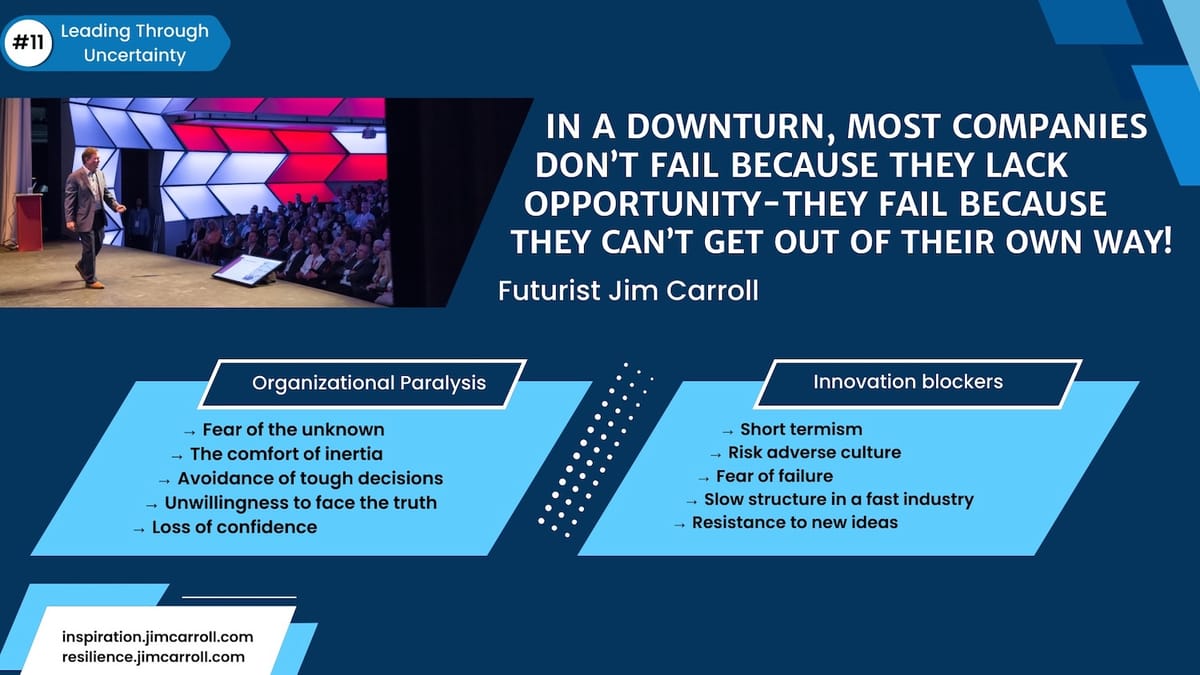"In a downturn, most companies don’t fail because they lack opportunity - they fail because they can’t get out of their own way." - Futurist Jim Carroll

Leaders build. Managers cut. That much is known. What is also known is that if you want to grow during a downturn, now is the time to move, not wait.
But let’s be honest. You can’t build what’s next if you’re still stuck in what’s holding you back.
That’s what this post is about.
Before you get into a growth mindset in a downturn - which seems like a contradiction - you have to face the barriers that will hold you back. And here's what I know from the advising leadership team during every major downturn since 2001: recessions don’t just expose economic volatility. They expose internal vulnerability.
What are those vulnerabilities? Business models that no longer fit. Teams that are afraid to act. Cultures allergic to risk. Short-term thinking that kills long-term opportunity. Things like that. Over time, I've seen a clear pattern emerge in the way organizations respond to volatility - there are two kinds of companies:
- those who got stuck in their economic rut, too paralyzed to move
- and those who became fast, focused, and fearless innovation leaders
Both types were in the same economy - but only one type made it to the other side stronger.
So what separates them? It’s not industry. Not funding. Not even market conditions. It’s this: the ability to confront what’s really holding them back. Because the reality is big disruption happens during big uncertainty, but most companies miss it, because they’re too focused on defending the past instead of designing the future.
Back in the wake of the '08 recession, I wrote a blog post that shared thoughts on ten reasons that are slowing companies down from succeeding during the downturn. It's wildly relevant at this moment in time.
First, there is organizational sclerosis, specifically emotional and structural forces that freeze progress. Let's call it baggage. This includes:
- fear of the unknown. Many leaders live in “what if” mode. What if the market doesn’t bounce back? What if customers don’t return? What if the top line doesn’t recover? The result? Paralysis. The entire organization freezes, afraid to move, afraid to decide, afraid to commit.
- inertia is easy. Doing nothing becomes the default. Repeating pre-downturn behaviors feels familiar - but familiarity is not a growth strategy. Hoping yesterday’s habits will somehow carry you through a very different tomorrow is a dangerous illusion.
- avoidance of tough decisions. Disruption brings hard choices - around talent, structure, priorities, and markets. But many teams would rather wait it out than make the call. They delay key actions, pretending things might go back to normal. Spoiler alert: they won’t.
- unwillingness to confront the truth. A recession reveals all the cracks: outdated products, irrelevant brands, and underperforming teams. Good times hide mistakes. But now is the time for reality checks and action. Some leaders don’t want to look in the mirror. That’s a risk you can’t afford.
- loss of confidence. Some leaders simply lose faith that they can adapt. They no longer trust their resilience. But confidence isn’t passive. It’s not something that magically returns. It’s built by moving forward, even when you don’t feel ready.
Then there are the mindsets that block future-focused thinking)
- a short-term obsession. Many organizations are stuck in a three-month mindset. But opportunity lives on longer timelines. If you can’t think beyond next quarter, you’ll miss the five-year transformation already underway in your industry. The future belongs to those who think in strategic horizons: 1 month, 6 months, 1 year, 10 years.
- risk-averse cultures. So far, you’ve survived by playing it safe. But caution isn’t enough anymore. The volatility has exposed your reluctance to try new things. Real growth now requires risk tolerance and a culture that supports experimentation, not perfection.
- an ongoing and relentless fear of failure. In too many teams, failure is punished. Mistakes are whispered about. Innovation is avoided because the risk is unacceptable. But in a fast-moving world, failure is a teacher, not a threat. You need to try, test, learn, and try again.
- a slow structure in a fast industry. Your product pipeline? It’s too slow. Your customer insight? Months out of date. Your internal approval process? Bureaucracy on autopilot. Fast markets require fast action. You need to move as quickly as your customers do, or risk losing them.
- resistance to new methods and new ideas. Every industry has new ideas, new tools, and new processes. But are you embracing them? Or rejecting them because they’re unfamiliar? The global idea machine is running 24/7. Tune in. Rethink how you do things, from the ground up.
By letting these things hold you back during a downturn, you'll never be ready for the upturn. Remember that key phrase from Bill Gates: “We always overestimate the change that will occur in the next two years and underestimate the change that will occur in the next ten.” While this period of economic uncertainty is ugly and will likely go on for some time, do you know where you could be ten years from now? What trends might be unfolding right now that could provide for massive future growth?
Right now, that underestimation is your biggest risk - so before you plan for growth - clear the path. You can’t implement a bold growth strategy on a foundation of fear, avoidance, or old habits. You have to unfreeze before you accelerate.
So ask yourself:
What’s holding you back right now?
What decisions are you avoiding?
What assumptions or habits are you still clinging to?
Because before you can talk about growth strategy…before you can reimagine business models…before you can disrupt...you need to confront what’s holding you back.
This isn’t about what’s happening around you.
It’s about what’s happening inside your organization.
Futurist Jim Carroll believes that this current moment in time is as much an innovation story as it is a recession story. Act accordingly.

